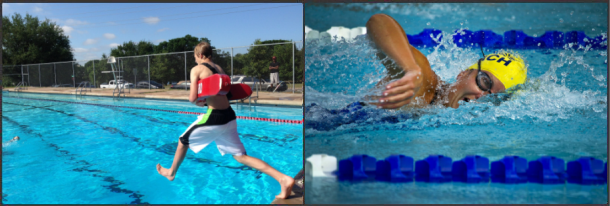Open water is very unpredictable. Thus, dangers include strong currents, riptides, potential cramps or strong feelings of fatigue.
What classes as open water?
Open water is an unlimited amount of water space. This includes sea, ocean, lake and rivers.
What type of currents are there?
Generally, there are only two types of currents. The surface current is driven by winds and is quite powerful. Then there are deep ocean currents. These currents are caused by temperature, ocean floors or changes in salinity. As the name states, they occur in the depths of an ocean.
Another variation of currents is the difference in rip currents. There are channelized rip currents, which will have a dark path which parts the waves breaking. The flash rip currents often start very suddenly. Most commonly, a circular motion will form a whirlwind of water and sand.


How do I identify currents?
The easiest way of identifying a current is if you can stand a bit higher up and can see the ocean or sea from above. Rip currents which are channelized will appear darker and, as the name states, will form a channel-like path. So look at the breaking waves and see if there is a disruption in the white lines.
How to avoid getting caught in a current?
Although oceans and seas are unpredictable, one can still take some preparatory steps.
Check out the weather conditions on the day you plan to go for a swim. Also, check the water conditions. This implicates checking a local beach forecast which will have more of a focus on the weather conditions around the beach, which will then tell how the water conditions will be. Also, talk to lifeguards as they will have more information on whether swimming is recommended.
Speaking of a lifeguard, make sure to be in the presence of one to avoid life-endangering situations. Try not to go into the water alone, have someone with you at all times or at least have someone in the know of you going into the water.
What to do if you are caught in a current?

It is recommended not to swim too far away from a lifeguard. Especially oceans can be very unpredictable, with very strong currents.
However, if you are in a situation where you are caught in a current, there are some steps to keep you safe.
A common mistake people tend to make when they feel a current is to swim against it. However, currents are strong, so all you will achieve is massive exhaustion. Try to swim out of the current. As mentioned previously, channelized riptides are the most common currents; try to swim to the side of the current path. If you do not manage to swim out of the current, then try to let your body relax and float with the current. Currents do not pull you under.
Try to yell and wave for help as much as possible, as you will feel fatigued, and extra help from a lifeguard will be needed.
What if you see someone getting caught in a current?
Do not go into the water when there is a current, yourself, without a floating device. Make sure to have a floating device; more advisable, however, would be to inform the lifeguard as quickly as possible.
Swimming in open waters is very fun and most holidays consist of a good swim in the ocean or sea. However, never underestimate the power of open waters! Be careful and take care!
Lifeguard Services
Lifeguard services provide an easy way to hire a fully qualified lifeguard for permanent, short and long term hire. We provide an easy way to make sure your allocated water is in safe hands. We can come to your school, outdoor event, party and more. To find out more and book please see our booking page.




Leave a Reply